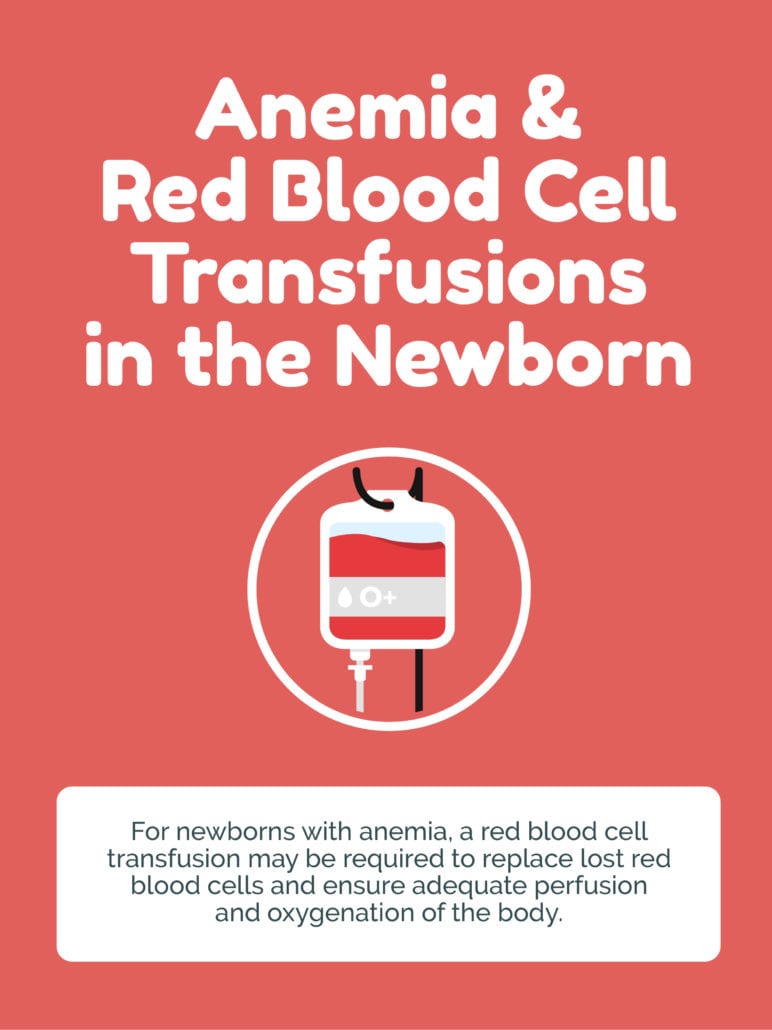Red Blood Cell Transfusions in the Newborn
Red blood cells (RBCs) play an important role in human health – they transport oxygen from the lungs to the organs and tissues, a process essential for appropriate organ function. Because of their crucial role, it is imperative that the number of red blood cells in the human body remains above a certain level. When RBC levels are low, a person is considered to be anemic. Anemia, if left untreated, reduces the body’s ability to carry oxygen to tissues, leading to damage and failure of organs (including the brain), bone marrow damage, and other severe consequences (1)
All mothers and babies are at risk for blood loss during labor and delivery and therefore are also at risk for anemia. Because of their size, newborns have a small blood volume and are at significant risk of injury due to blood loss. For newborns with anemia, a red blood cell transfusion may be required to replace lost RBCs and ensure adequate perfusion and oxygenation of the body. If mismanaged, low levels of red blood cells in the body can lead to permanent conditions such as hypoxic-ischemic encephalopathy (HIE), cerebral palsy, and more.

Low red blood cell levels in the newborn: A cause for concern
When the number of red blood cells in the body drops, a blood transfusion may be required to prevent severe, irreversible damage to the organ systems of a newborn. If any of the following three causes is present and severe, a red blood cell transfusion may be required to restore healthy RBC levels:
- Blood loss. The most common cause of anemia is blood loss. Blood loss in a newborn may be due to obstetrical incidents like placental abruption or placenta previa; trauma during birth; fetal exchange of blood between the mother, placenta, or a twin in the womb; internal hemorrhaging; or even from blood sampling for laboratory testing (2).
- Increased red blood cell destruction. When RBCs are destroyed at a rate that is higher than usual, a newborn’s body may not be able to replenish the RBC supply adequately. Increased RBC destruction can be caused by hereditary disorders, immune reactions to blood type incompatibility, infection, vitamin deficiency, or responses to particular drugs (2).
- Decreased red blood cell production. When RBCs are produced at a rate that is slower than required, the body’s RBC level will be lower than it should be. Decreased RBC production can be present due to conditions such as anemia of prematurity, bone marrow disorders, or nutritional anemia (2).
Determining if a red blood cell transfusion is necessary
Practitioners utilize a patient’s clinical history, presenting signs and symptoms, and values obtained via laboratory blood testing to determine the necessity of a red blood cell transfusion in a particular newborn.
Clinical history
An interdepartmental conference well in advance of delivery between the obstetrical team and the neonatal caregivers is critical in determining whether a blood transfusion will be needed at birth (10). At a meeting of this type, the obstetrical staff must report important information including the history or presence of any condition which increases the risk of anemia at birth.
Conditions like placenta previa, placental abruption, anterior placenta, blood type incompatibility, and maternal blood loss must be mentioned. Also, the obstetric team should fill the neonatal caregivers in on the plan of delivery and any other factors crucial to the subsequent care of the newborn.
Signs and symptoms of low RBC levels (anemia)
Physicians must be on the lookout for signs that indicate low levels of RBCs in the body. It is especially essential that physicians note these symptoms and promptly make the decision to treat a newborn in case acute blood loss occurred. If significant blood volume is lost, and treatment is delayed, a baby can go into hypovolemic shock, a condition in which the heart is unable to pump the appropriate amount of blood to the body. Hypovolemic shock can lead to organ failure, hypoxia, and acidosis. Though some newborns may be asymptomatic, when symptoms of anemia do occur they may include (1):
- Pale or jaundiced (yellow-ish) skin
- Poor feeding
- Lethargic or sluggish movements
- Tachypnea (rapid breathing)
- Respiratory distress
- Tachycardia (rapid heart rate) or bradycardia (slow heart rate)
- Hypotension (low blood pressure)
- Acidosis
- Poor growth
- Little or no urine output
Hemoglobin & hematocrit (H&H)
The two laboratory values used to determine levels of RBCs in the blood are measurements of hemoglobin (a protein in red blood cells) and hematocrit (the fraction of the blood composed of red blood cells), known more commonly as ‘H&H’ (1). While these two values together should theoretically provide physicians with a clear picture of the RBC levels in the body, this clear picture is sometimes obstructed by certain clinical factors.
When the H&H levels are taken shortly after a hemorrhage, or during an episode of blood loss, they will not accurately reflect the number of RBCs in the body (3,4). This is because during a hemorrhage the plasma and the red blood cells are lost in equal proportions, making an H&H reading shortly after a hemorrhage appear normal, as the proportion of RBCs relative to plasma level remains constant. However, after several hours, when the volume of plasma increases to make up for the loss of blood, the RBC levels remain low because the production of RBCs takes several days (3). At this point, the proportion of RBCs to plasma in the blood will begin to reflect the true nature of the blood loss.
Because of the varying reliability of H&H values in certain situations, especially when there is a rapid blood loss, it is crucial that physicians take into account the full clinical picture. In some circumstances, a blood transfusion must be given immediately based on clinical signs alone to prevent damage from shock.
Red blood cell transfusion: blood products
Once it has been determined – based on clinical history, signs and symptoms, H&H levels, or a combination of the three – that a red blood cell transfusion is necessary, blood products must be ordered from a hospital’s blood bank. Circumstances in which the neonatal team is aware in advance that blood loss is likely, blood products will be ordered ahead of time so that a transfusion can be performed immediately. The ordering process follows specific procedures to ensure that the correct blood is administered to the correct patient at the correct volume.
While some hospitals perform pretransfusion blood testing, such as a “type and screen” or a “type and crossmatch,” to ensure that newborns receive blood compatible with their specific blood type (A, B, AB, or O) during a transfusion, it is safe for most newborns to receive what is known as “universal donor” blood. Universal donor blood is of type “O-negative,” meaning that it does not contain A or B antigens on its red blood cells, and therefore will not react with the antigens in A, B, AB, or O type blood. In addition, this universal donor blood is Rh(D) negative, meaning that it lacks the Rh (Rhesus) factor that may react with Rh-positive blood in transfusion recipients (5).
Many hospitals use O-negative universal donor blood for all neonatal transfusions since antibody production in infants under four months is limited, and the likelihood of a transfusion reaction is low (5). For hospitals that do not use universal donor blood as the standard for newborns, universal donor blood can be accessed in an emergency through what is known as an “emergency release” protocol. In situations when pretransfusion crossmatch testing cannot be performed in time to safely carry out the transfusion, an emergency release order must be placed to the blood bank, and O-negative Rh(D) blood should be transfused as quickly as possible (6). Emergency release blood is available from the blood bank within minutes and is the blood that is given to save lives when there is no time to ask questions.
Communication regarding risk for hemorrhage and blood loss
Communication between care teams for mothers and their babies is always essential; without meaningful discussions regarding the risk for hemorrhage and blood loss, significant warning signs and risk factors for anemia and hypovolemic shock (in which significant blood loss prevents the heart from pumping adequate blood through the body) can fall through the cracks (10).
This is especially true during the labor and delivery process when all moms and babies are at risk for blood loss. ACOG and the Joint Commission published on the dangers of postpartum hemorrhage (8).
When there is a risk for blood loss, decreased RBC production, or increased RBC destruction before delivery, or when a mother endures trauma during childbirth, it may be necessary to transfuse the mom, the newborn, or both, immediately after birth. In such circumstances, the obstetrical team and the neonatal teams should have blood prepared and present in the delivery room for an emergent transfusion (7,9).
Significant blood loss causing hypovolemic shock, when left untreated, leads to permanent injury to the body’s tissues from decreased perfusion and oxygenation. In emergent situations, such as a large bleed during labor or delivery, a hospital must have life-saving blood available within minutes for the mom and the baby.
Complications of mismanaged red blood cell transfusions
If medical professionals fail to recognize blood loss, anemia, or abnormal red blood cells, or if they fail to quickly perform a necessary transfusion, serious complications can arise. The following are common complications and disabilities associated with mismanaged red blood cell transfusions (11):
- Hypovolemic shock
- Kernicterus
- Organ failure
- Brain damage
Because of the immense risks associated with low levels of RBCs in the body, it is crucial that medical professionals communicate, quickly recognize when a blood transfusion is necessary, and promptly administer the appropriate blood products. In many cases, red blood cell transfusions can be life-saving in the face of blood loss.


Legal help for mismanaged blood transfusions for infants
If you suspect that your child or loved one suffered from a permanent injury from a mismanaged red blood cell transfusion as the result of medical negligence, you may want to consider pursuing legal action. The award-winning attorneys at ABC Law Centers: Birth Injury Lawyers (Reiter & Walsh, P.C.) focus exclusively on malpractice that occurs during pregnancy, birth, or the neonatal period. They also work closely with an in-house medical team, which enables them to delve deeper into complex medical issues.
To find out if you have a case, please reach out for a free case review. We have numerous testimonials and multi-million dollar verdicts and settlements that attest to our success, and you pay nothing unless we win your case.
Featured Videos
Posterior Position
Hypoxic-Ischemic Encephalopathy (HIE)

Featured Testimonial
What Our
Clients Say…
After the traumatic birth of my son, I was left confused, afraid, and seeking answers. We needed someone we could trust and depend on. ABC Law Centers: Birth Injury Lawyers was just that.
- Michael
Helpful resources
- Robin Ohls, “Red blood cell transfusions in the newborn,” UpToDate (2017): https://www.uptodate.com/contents/red-blood-cell-transfusions-in-the-newborn
- The Regents of the University of California, “Neonatal Anemia,” Intensive Care Nursery House Staff Manual (2004): https://www.ucsfbenioffchildrens.org/-/media/project/ucsf/ucsf-bch/pdf/manuals/37_anemia.pdf
- RnCeus, “Hematocrit,” RnCeus.com: http://www.rnceus.com/cbc/cbchct.html.
- Joseph E Maakaron, “Anemia Workup,” Medscape (2016): http://emedicine.medscape.com/article/198475-workup#c11.
- Jun Teruya, “Red blood cell transfusion in infants and children: Selection of blood products,” UpToDate (2017): https://www.uptodate.com/contents/red-blood-cell-transfusion-in-infants-and-children-selection-of-blood-products.
- Ira A Shulman, Joseph Morales, Janice M Nelson, and Sunita Saxena, “Emergency Blood Transfusion Protocols,” Laboratory Medicine (1989): 166-168, https://watermark.silverchair.come/labmed.
- Joni Scholz, “ABCD – Emergent Neonatal Blood Transfusion In the Delivery Room,” Proceedings of the 2011 AWHONN Convention (2011): S133.
- The Joint Commission, “Preventing Maternal Death,” Sentinel Event Alert (2010): Issue 44.
- Main, E.K., Goffman, D., Scavone, B.M., Low, L.K., Bingham, D., Fontaine, P.L., … Levy, B.S., “National Partnership for Maternal Safety, Consensus Bundle on Obstetric Hemorrhage,” Obstetrics & Gynecology (2015): Volume 126 (Number 1), 155-162.
- Institute for Healthcare Improvement / National Patient Safety Foundation, “Closing the Loop: A Guide to Safer Ambulatory Referrals in the EHR Era,” Institute for Healthcare Improvement (2017).
- Walter, A. W. (2017, September). Anemia in the Newborn – Children’s Health Issues. Retrieved from https://www.merckmanuals.com/home/children-s-health-issues/blood-problems-in-newborns/anemia-in-the-newborn.


